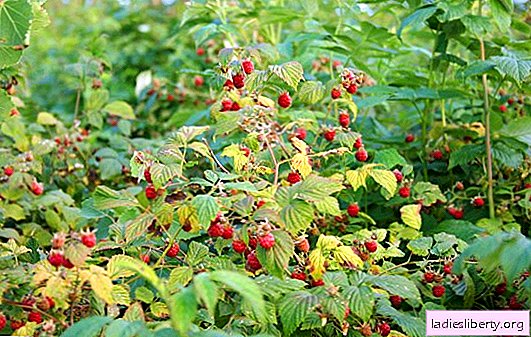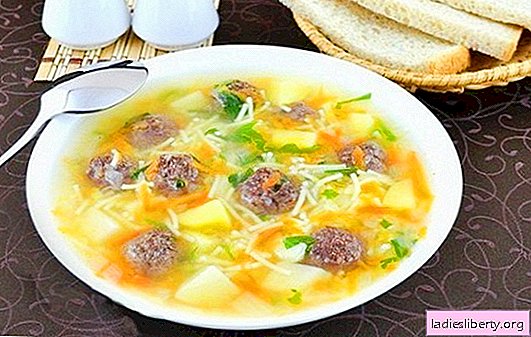
In autumn, raspberry leaves begin to turn yellow; this is a natural process that should not be alarming. But many gardeners often complain that the leaves of the shrub turn yellow and curl in the summer, before the berries ripen or at the time of harvest. This phenomenon is not considered the norm and it is worth paying close attention to the problem of yellowing of leaves in raspberries.
Causes of yellowing raspberry leaves in summer
There are several main reasons why the leaves of the shrub begin to turn yellow and curl:
1. Raspberry Root Cancer
The cause of yellow leaves is often the root cancer of the plant. A disease affecting the roots of raspberries can be easily identified by the appearance and condition of the plant. First of all, the gardener should alert the dwarf young lashes that do not develop, the yellow color of the leaves in the summer. Pathogenic blisters can often be found on the roots of such a bush. Harvest loses its taste, becomes tasteless.

It is impossible to treat the disease. Raspberries are not treated with chemicals, shrubs uproot and burn.
Important! In the area where damaged bushes are found, raspberries are not planted for the next eight years.
Raspberry planting can be protected from root cancer by carrying out preventive measures:
It is necessary to monitor the cleanliness of the beds, promptly remove weeds, loosen the aisles.
Raspberries are best planted after legumes.
Waterlogging of the soil and the formation of a crust should not be allowed; after watering, it is necessary to loosen the earth around the bush.
When replanting old bushes, they must be examined for the presence of diseases. Planting material is soaked for several hours in a solution of copper sulfate.
Fertilizers will help prevent root disease. Raspberries need timely application of phosphorus-potash fertilizers and humus.
Applying comprehensive measures to combat root cancer can save raspberries.
2. Jaundice on raspberries
A common raspberry disease - yellow mosaic or chlorosis, popularly - jaundice on raspberries, is an infectious disease. This disease progresses rapidly and is capable of quickly destroying the entire crop.
It is possible to determine chlorosis on raspberries by the state of shrubs and shoots during the growing season. The first signs of damage appear immediately with the start of plant growth. Leaves on young shoots up to two years old turn yellow, apical buds suffer more. The color of the stalks, brushes and lashes also changes. The shoots are thinned and extended, the berries dry.
At the initial stage of the lesion, the leaves do not completely yellow, spots appear. The shape of the leaves themselves does not change, but they stop developing and remain small.

Jaundice on raspberries causes general suppression of the bush, its productivity decreases, but complete death does not occur.
The fight against the disease should be aimed at enhancing the immunity of the plant.
For planting, only healthy material is used.
Inspect shrubs in a timely manner, identify damaged plants and conduct treatment.
It should be remembered that the immunity of a plant is greatly reduced if it is affected by aphids and other sucking insects. Spray against pests.
To apply mineral and organic fertilizers for planting.
Further development of the disease occurs during the appearance of berries, when the leaves turn completely yellow. After harvesting, the disease subsides for a short while, but its course worsens in the fall.
3. Non-infectious raspberry chlorosis
Often, shrub disease is associated with climatic conditions and soil conditions. Raspberry leaves turn yellow and die.
Non-infectious chlorosis does not inhibit the growth of healthy shoots, the leaves on them are larger. Raspberry flowers and brushes are smaller, berries acquire a bad taste, often dry out. Affected bushes practically do not grow in length, by the end of the season they become very thickened.
The disease is easily treatable; it is enough to transplant the shrub to a more suitable place. Non-infectious chlorosis occurs due to waterlogging of the soil and a high content of calcium in it. In areas with such soil before planting, you need to increase the alkalinity of the soil.
In early summer, plantings are sprayed with Bordeaux liquid, which has a beneficial effect on the general condition of plants. During the growing season, it is useful to introduce iron sulfate into the soil as fertilizer.
4. Rust on raspberry leaves
The disease is caused by a pathogenic fungus that settles on the underside of the leaves. At the end of spring, brown spots can be found on the back of the leaf, which subsequently lead to its yellowing and falling. Brown ulcers form on raspberry stalks and shoots.
For prevention, spraying bushes with a 1% solution of Bordeaux fluid. Affected plants are subject to destruction.
Complex measures will help prevent the disease:
the remains of all leaves are removed and burned in autumn;
during the season, feeding raspberries with manure is mandatory;
More resistant to disease varieties are planted in the garden.

Raspberry leaf curl: causes and treatments
Raspberry leaves often curl for some reason that indicates disease and pest damage. Timely established facts of leaf deformation allow you to safely get rid of the disease and get a full crop.
1. Lack of trace elements
Lack of nutrition often leads to curling leaves on raspberries. Deficiency of nutrients, in particular boron, is manifested by leaf deformation. Eliminate the problem of nutrition will help feeding boric acid. To do this, prepare a solution for irrigation at the rate of 5 grams of boron per 10 liters of water.
Rotting the sheet from below and twisting it is observed due to a lack of potassium. You can help the plant by feeding it with ash.
2. Fungal anthracnose
This disease leads to curling leaves on raspberries. You can recognize the disease by gray spots, dry twisted leaves and unripe fruits. When the bush is affected, all diseased shoots are clipped, after which the plant is sprayed with a solution of Bordeaux fluid.

General recommendations: what to do with yellowing and curling raspberry leaves
Many diseases of raspberry, which cause yellowing of the leaves and their twisting, arise due to the incorrect location of shrubs and the acquisition of poor-quality planting material. The question of planting raspberries on the site must be approached responsibly: choose disease-resistant varieties, properly arrange plantings.
At the first signs of the disease, do not use chemicals, it is better to use gentle substances. If the disease progresses, you need to uproot the plant and burn it.
It is important to remember that the aphid is the carrier of many diseases, so you need to deal with the pest immediately after detection. With the beginning of the growing season, shrubs are sprayed with a 1% solution of Bordeaux mixture. To successfully grow raspberries, you need to regularly trim the shoots. Good planting ventilation is achieved by growing on trellises.











